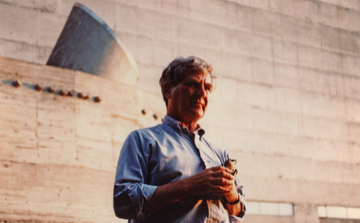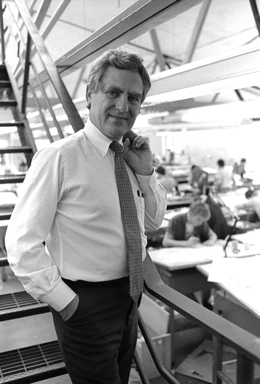
Who was Werner Seligmann?
“To classify Werner Seligmann as another modern architect would be an understatement. Seligmann was the embodiment of what it meant to be a 20th century architect during his lifetime. He was a consummate student and teacher of architecture, pursuing both with a passion that touched the lives of many. Seligmann maintained a life-long active professional practice. In fact, of all the people associated with the Texas Rangers, he was the only one to do so. Others, such as Hejduk, Hodgden and Shaw, built on occasion. But if one wants to know what the work of the Rangers, and the principles on which they based their teaching, looks like when built, one must look to Seligmann.”*
Werner Seligmann was born in 1930 in Osnabrück, Germany. His father was a violinist with the local orchestra, from whom he derived a lifelong appreciation for music and the arts in general. As a teenager, he was briefly apprenticed to an architect in nearby Münster. It was in that office that he discovered publications devoted to De Stijl which he said, “Opened my eyes!”
In 1949, after the end of WWII, he moved to the US to live with relatives in the small town of Groton, in the Finger Lakes region of central New York, a short distance from Cornell University in Ithaca. That move proved to be propitious, as he would receive his BArch from Cornell in 1955; and, by the time of his graduation, he had already designed and built three houses in the region.
He was recruited to teach as an Instructor at the University of Texas at Austin from 1956–58, where he became identified with a small group of faculty that would later be nicknamed The Texas Rangers. The group included Colin Rowe, John Shaw, Robert Slutsky, Lee Hodgden and John Hejduk. After the group was dismissed from Austin, for indoctrinating the students, from 1959–61, he became an assistant, at the Eidgenössische Technische Hochschule (the ETH) in Zurich, to Bernhard Hoesli, a Swiss architect, who had worked in the office of Le Corbusier in the late 1940s.
During this period he worked on and off for Sargent Webster Crenshaw & Folley (SWCF), a Syracuse-based production firm, specializing in educational facilities, with a temporary branch in Corning, New York. This proved also to be auspicious for several reasons:
• Seligmann worked only briefly at each office, but at each location he was able to meet clients for his first house projects, thereby explaining their locations in the Corning and Syracuse areas.
• A continued positive association with SWCF, allowed him to get his first, major public-sector commission in 1963—a Science Building addition at the newly-designated SUNY Cortland—even though he had only one full-time employee.
ii
*The Texas Rangers, Notes from an Architectural Underground, Alexander Caragonne, Boston, Mass 1995.
